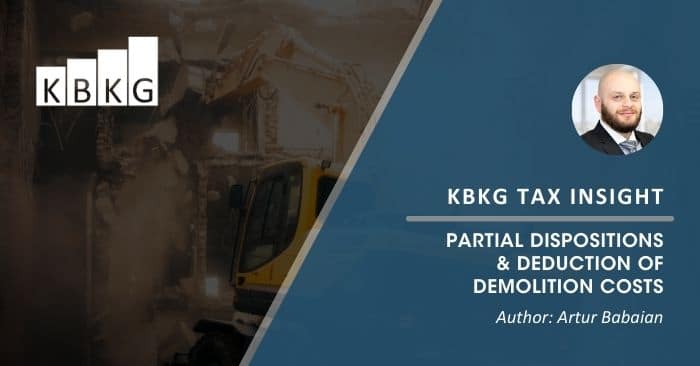Subsequent to the acquisition of a property, taxpayers often incur capital expenditures related to property renovations and improvements. As this work occurs, the existing components are often removed or disposed of. IRC Section 1.168(i)-8(d)(2) allows taxpayers to realize a gain or loss by making an election to partially dispose the adjusted basis of the aforementioned assets. This election may be made by taxpayers having a depreciable interest in a building or its structural components. To make this election, the following key conditions must be met:
- Previously acquired assets must meet the definition of a depreciable asset (Publication 946)
- The gain or loss must be reported on a timely-filed original tax return, including extensions, for the tax year in which the portion of the asset is physically disposed of
- 75 percent or more of the existing external walls of the building are retained in place as internal or external walls (Proc. 95-27, 1995-1 CB 704)
- 75 percent or more of the existing internal structural framework of the building is retained in place (Proc. 95-27, 1995-1 CB 704)
KBKG Insight:
In the event that less than 75 percent of the existing external walls or internal structural framework are retained, no disposition is allowed. Instead, the adjusted basis is added to the cost of land on which the structure is located on.
In order to quantify the adjusted basis of disposed assets, taxpayers will first need to compute the unadjusted basis of these assets. IRC Section 1.168(i)-8(f)(3) suggests that if it is impracticable to determine the unadjusted depreciable basis from the taxpayer’s records, a reasonable method should be used, including:
- If the replacement asset is a restoration, the Producer Price Index (PPI) for Finished Goods, Final Demand, or their successors
- A pro rata allocation of the unadjusted depreciable basis based on the replacement cost of the disposed asset and the replacement cost of all assets
- A cost segregation study
KBKG Insight:
In the case that a cost segregation study of the original acquisition is not deemed feasible, KBKG also offers an online software Partial Disposition Calculator which is powered by the PPI index.
As an added benefit to electing to partially dispose of a depreciable asset, IRC Section 1.263(a)-3(g)(2) allows taxpayers to deduct the costs of removing (or demolishing) the asset or component. If a taxpayer fails to realize the partial dispositions on a timely-filed original tax return, they would lose this opportunity to deduct the removal costs associated with the partial dispositions and would be required to capitalize the costs alongside the capital expenditures.
Contact a KBKG specialist to discuss options on how to maximize tax deductions, generate losses, or the effects on credits calculated in prior years. Our team is available to discuss dispositions and how it may impact your tax situation.
Author: Artur Babaian
Contributors: Lester Cook; Malik Javed; Gian Pazzia
Download KBKG Tax Insight: Partial Dispositions & Deduction of Demolition Costs
About the Author
 Artur Babaian – Manager
Artur Babaian – Manager
Pasadena
Based in Pasadena, California, Artur Babaian is a manager with KBKG for the Cost Segregation practice and primarily oversees the West Coast region. He consults with business owners and tax preparers on strategies to reduce their tax liabilities utilizing cost segregation, asset retirement, repair and expense, and fixed asset review analyses. » Full Bio


